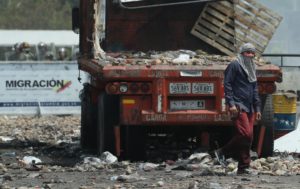Cucuta, Colombia, Feb 24 (EFE).- Dawn broke on Sunday at the Simon Bolivar bridge, the main border crossing point between Colombia and Venezuela, amid a tense and uncertain calm after a clash between Venezuelans – many of them shouting and calling for their country’s “freedom” – who were trying to bring humanitarian aid into their country and authorities taking orders from Caracas.
On the order of Colombian President Ivan Duque, the bridge linking the Colombian city of Cucuta with Venezuela’s San Antonio del Tachira was closed for two days while the damage resulting from the failed aid delivery attempt is evaluated.
The area near the bridge was cordoned off and is being guarded by Colombian soldiers, police and some members of the Esmad anti-riot squadron.
In addition, the bridge is being blocked on the Venezuelan side by a tanker truck, with a number of masked men deployed in the area along the Tachira River on the Colombian side.

Venezuelan lawmaker Gaby Arellano said Sunday that smoke was still emanating from the two aid trucks that were set afire by the Bolivarian National Police.
Norte de Santander provincial Gov. William Villamizar told reporters that he hoped that the situation would normalize at the border crossing points, but that Colombia will continue to take care of Venezuelans who cannot return to their country.
The Venezuelan opposition, which does not recognize the new six-year term to which Nicolas Maduro was inaugurated on Jan. 10, said that the country is going through a “complex humanitarian emergency” and has asked for the international community to help deal with it.
It has been expected that aid donations would begin being ferried into Venezuela amid a huge citizen mobilization after pressure exerted by opposition leader and self-proclaimed Venezuelan President Juan Guaido, but the attempt was violently thwarted by Maduro’s military forces and police from the Venezuelan border towns.
In contrast to Saturday, just a handful of Venezuelans approached the border crossing point to continue providing support for the plan to bring emergency aid into their country.
Supporting the aid delivery was Maryelyn Jaspe, a student who arrived from Cucuta to join Saturday’s demonstration.
“I’m coming here today because we’ve suffered a lot, we’re tired, we’ve suffered in a peaceful manner, but we want to get out of this situation,” she told EFE.
Like many of those present at the site, Jaspe said she did not know how or when she might be able to return to Venezuela, but she said she did not plan to return illegally due to the risk she would be running in doing so.
The disturbances on Saturday – as Colombian Foreign Minister Carlos Holmes Trujillo said on Saturday evening – left 285 people injured, of whom 255 are Venezuelans and 30 are Colombians.
The majority of those people were affected by tear gas and by the use of “unconventional weapons” such as rubber bullets, birdshot and other anti-riot weaponry.
Meanwhile, on Sunday Colombian Vice President Marta Lucia Ramirez confirmed that more than 120 members of the Venezuelan military deserted after Saturday’s violence.
“In a single day, more than 120 officers, non-commissioned officers and soldiers of the FANB (Bolivarian National Armed Forces) of Venezuela placed themselves – on the orders of Juan Guaido – on the constitutional path to remove the dictator (Maduro) who abusively occupies Miraflores (presidential palace). The slogan: Liberate the Venezuelan people and return democracy to them,” said Ramirez, who accompanied Duque on a Sunday tour of the Francisco de Paula Santander and Simon Bolivar border bridges.
Also on Sunday, four Colombian consuls returned from Venezuela after Colombian President Ivan Duque ordered them back home after Maduro decided to break “all relations” with the neighboring country.
Migracion Colombia, the country’s immigration authority, reported the returns in a communique at 11:22 am stating that the diplomats posted to the Venezuelan cities of San Cristobal, San Antonio, Puerto Ayacucho and San Carlos del Zulia arrived via different border crossing points.
